You’ll revive vintage jewelry through professional assessment and documentation, gentle deep cleaning with pH-balanced solutions, stone replacement with secure resetting, metal refinishing and electroplating, intricate enamel repair with precise color matching, leather and fabric component rehabilitation, strategic resizing for modern wearability, thorough historical research and authentication, creative redesign using original elements, and proper restringing with measured bead spacing. These expert techniques restore both beauty and structural integrity while preserving authenticity. Master these methods to transform forgotten treasures into stunning contemporary pieces.
Professional Assessment and Documentation of Heritage Pieces
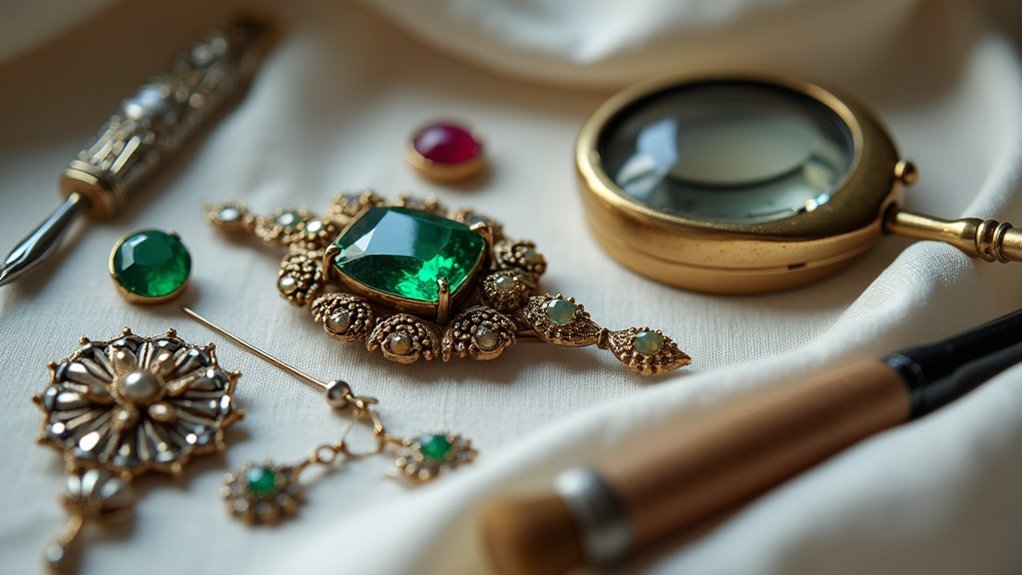
When you bring a cherished family heirloom to a professional jeweler, the restoration journey begins with a meticulous assessment that determines the piece’s current condition and guides every subsequent repair decision.
Every restoration begins with careful evaluation, where skilled artisans assess damage and determine the precise path forward for your treasured heirloom.
This professional assessment examines structural integrity by identifying damaged stones, worn prongs, and critical issues affecting restoration potential. Detailed documentation through notes and photographs tracks the entire process while preserving authenticity.
Your jeweler considers the piece’s historical significance, including its era and manufacturer, to select appropriate restoration techniques.
They’ll identify specific materials to determine suitable cleaning methods that maintain value and integrity. This thorough evaluation guarantees repairs align with original craftsmanship, protecting both the historical significance and sentimental value that makes your heritage piece irreplaceable.
Gentle Deep Cleaning With Specialized Solutions
After completing the professional assessment, your jeweler begins the delicate process of deep cleaning using specialized solutions formulated specifically for vintage materials. These pH-balanced cleaners protect delicate materials while effectively removing accumulated dirt and tarnish that’s dulled your piece’s original brilliance.
Your jeweler applies these solutions using soft brushes or cloths, ensuring no scratching occurs during cleaning. For gemstones like emeralds, they’ll use mild soap solutions rather than harsh chemicals that could compromise stone quality.
| Cleaning Method | Recommended For | Avoid For |
|---|---|---|
| pH-balanced solutions | Most vintage metals | N/A |
| Mild soap solution | Delicate gemstones | Pearls, opals |
| Ultrasonic cleaners | Modern sturdy pieces | Vintage fragile settings |
This gentle deep cleaning approach will restore the beauty while preserving your jewelry’s structural integrity for future generations.
Stone Replacement and Secure Resetting Techniques
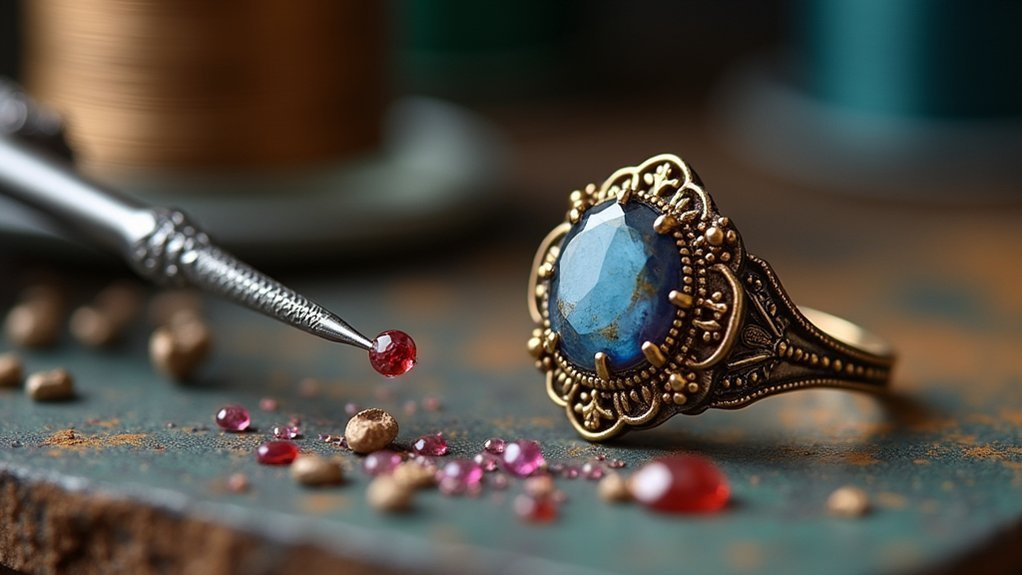
When you’re replacing stones in vintage jewelry, you’ll need to carefully match the original gemstone’s size, shape, and setting style to maintain the piece’s authentic appearance.
You should also focus on reinforcing worn prongs and settings using professional techniques that’ll secure your stones without damaging the surrounding metalwork.
Document the jewelry’s original condition before starting any work so you can guarantee your restoration maintains the piece’s historical integrity.
Matching Original Stone Characteristics
Since vintage jewelry pieces often suffer from missing or damaged stones, you’ll need to meticulously match the original stone characteristics to preserve both aesthetic integrity and historical value.
Document the carat weight, gemstone type, size, shape, and color of existing stones before sourcing replacement stones. This detailed record guarantees you’ll find accurate matches that maintain the piece’s authentic appearance.
Consult with a professional jeweler experienced in vintage jewelry restoration to source high-quality replacements. They’ll help you locate stones that closely replicate the originals.
Once you’ve secured appropriate replacement stones, utilize traditional resetting methods like bead setting or prong setting. These techniques preserve the original craftsmanship while guaranteeing your restored stones remain securely positioned without compromising the surrounding metalwork’s integrity.
Professional Setting Reinforcement Methods
Beyond sourcing the right replacement stones, you’ll need to focus on the technical aspects of secure stone setting that protect your vintage piece’s structural integrity.
A professional jeweler employs traditional metalworking techniques for setting reinforcement, carefully building up worn prongs with additional metal to maintain security for gemstones. During the restoration process, they’ll use specialized tools to align and tighten prongs through secure resetting techniques, ensuring stones remain firmly positioned and reducing future loss risks.
The jeweler will inspect all components for movement, as minor looseness can compromise stability.
They’ll document the original condition and modifications made, maintaining records that preserve your piece’s historical significance while ensuring proper restoration standards are met throughout the process.
Metal Refinishing and Electroplating Restoration
As vintage jewelry ages, its metal surfaces often lose their original brilliance through everyday wear, tarnishing, and accumulated scratches.
Metal refinishing can restore vintage pieces by carefully polishing and buffing away surface imperfections while maintaining the original design’s integrity. You’ll want to combine this with electroplating, which applies a protective thin metal layer to enhance appearance and prevent future tarnishing.
These restoration processes require precise voltage control and timing to achieve even coverage without damaging intricate details.
Only a professional jeweler should perform these techniques, as improper methods can cause uneven finishes or design loss.
When done correctly, metal refinishing and electroplating will preserve value and extend life considerably, ensuring your vintage jewelry maintains its aesthetic appeal for future generations.
Intricate Enamel Repair and Color Matching
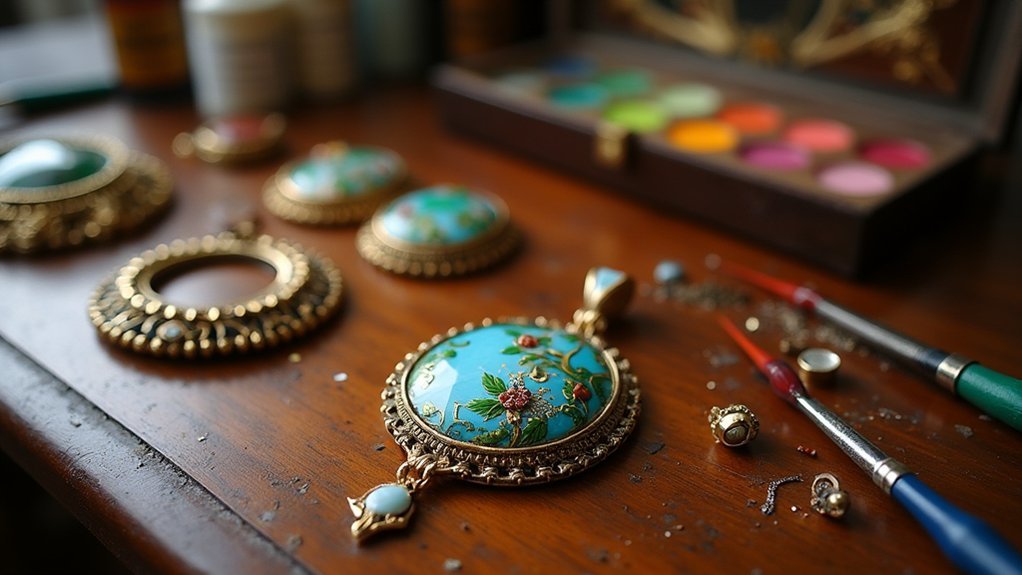
When enamel chips, cracks, or fades on vintage jewelry, you’re facing one of restoration’s most challenging tasks. Enamel restoration demands specialized techniques involving intricate cleaning before any repair work begins.
You’ll need precise color matching using original samples or professional color charts to achieve seamless results.
The restoration process requires:
- Layered application – Powdered glass and pigments are carefully applied in multiple layers to restore the original appearance
- High-temperature firing – Re-firing at precise temperatures guarantees proper adhesion and structural integrity
- Expert assessment – Professional evaluation determines the best approach for each unique piece
Given enamel’s complexity, you should consult an experienced professional jeweler who specializes in this delicate work.
They’ll restore the original vibrancy while preserving your vintage piece’s authenticity and value.
Precision Restringing for Vintage Beaded Pieces
You’ll need specific tools to successfully restring vintage beaded jewelry, starting with a quality bead stringing kit that includes needles, thread, and crimping supplies.
Proper bead spacing techniques guarantee you maintain the original design’s proportions while creating a secure, professional-looking result.
Master these fundamentals and you’ll transform fragile vintage pieces into wearable treasures that’ll last for generations.
Essential Restringing Tools
Five essential restringing tools form the foundation of any successful vintage jewelry restringing project, each serving a critical role in preserving these delicate treasures. Your bead stringing kit provides the core components—needles, thread, and clamps—necessary for accurate placement.
High-quality nylon or silk thread guarantees durability while maintaining the delicate appearance vintage pieces require.
Essential tools you’ll need include:
- Bead stoppers or tape – Prevent beads from sliding off during work
- Fine-tipped pliers – Enable precise knot tightening and closure securing
- Measuring tape – Confirm proper length for comfortable wear
These fine-tipped pliers prove invaluable when achieving a professional finish on delicate vintage jewelry.
Combined with proper measuring techniques, you’ll maintain the original design aesthetics while confirming each piece withstands future wear.
Bead Spacing Techniques
Precision determines the difference between amateur and professional restringing results when working with vintage beaded jewelry.
You’ll need to carefully measure spacing between each bead to maintain original design integrity throughout your restoration process. When implementing bead spacing techniques, document the original arrangement before disassembly to preserve historical context.
Select thread or wire matching the original material’s strength and flexibility for vintage pieces. Use spacer beads or knotting techniques between larger elements to enhance visual appeal while protecting delicate materials from friction damage.
Your bead stringing kit should include specialized tools designed for durability when handling fragile components.
Even spacing creates the aesthetically pleasing appearance that distinguishes professional restringing work, ensuring your restored piece maintains its authentic vintage character and structural integrity.
Leather and Fabric Component Rehabilitation
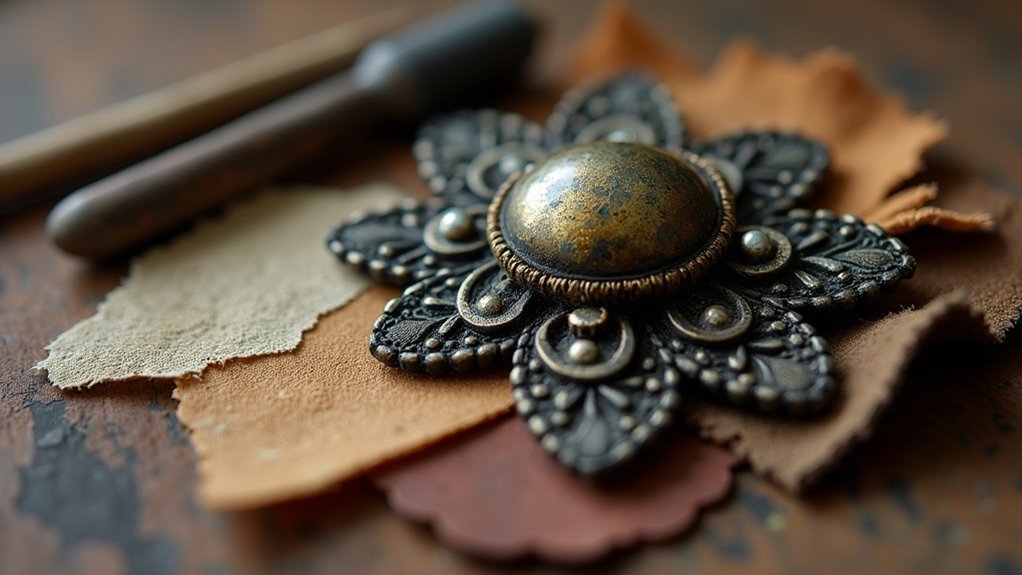
Vintage jewelry often features delicate leather and fabric components that require careful attention to restore their original beauty.
When rehabilitating fabric elements, you’ll need to test cleaning products on a small area first to prevent damage. Leather conditioner works wonders for softening dried material and bringing back natural color.
Key restoration steps include:
- Apply specialized cleaning products designed for fabric to remove stains without damaging fibers
- Use leather conditioner regularly to prevent cracking and extend component lifespan
- Implement proper storage in cool, dry locations away from direct sunlight
You can successfully restore these materials by starting cautiously and using appropriate products.
Proper storage after restoration helps prevent deterioration, ensuring your vintage pieces maintain their renewed beauty for years to come.
Strategic Resizing for Modern Wearability
Three critical factors determine successful vintage jewelry resizing: original construction quality, available adjustment points, and preservation of historical authenticity.
Strategic resizing transforms unwearable pieces into cherished accessories while maintaining their vintage character. You’ll need professional expertise to guarantee the integrity of your original piece remains intact throughout the process.
When resizing rings, jewelers carefully add or remove band material without compromising gemstone settings or intricate design elements. For bracelets and necklaces, they’ll strategically add extenders or matching links to enhance wearability.
You can’t overlook how proper resizing affects marketability—well-fitting vintage jewelry attracts more potential buyers than pieces requiring significant adjustments.
The key lies in preserving historical authenticity while adapting dimensions for modern wear. Professional jewelers understand which vintage pieces can accommodate resizing without losing their essential character and value.
Historical Research and Authentication Process
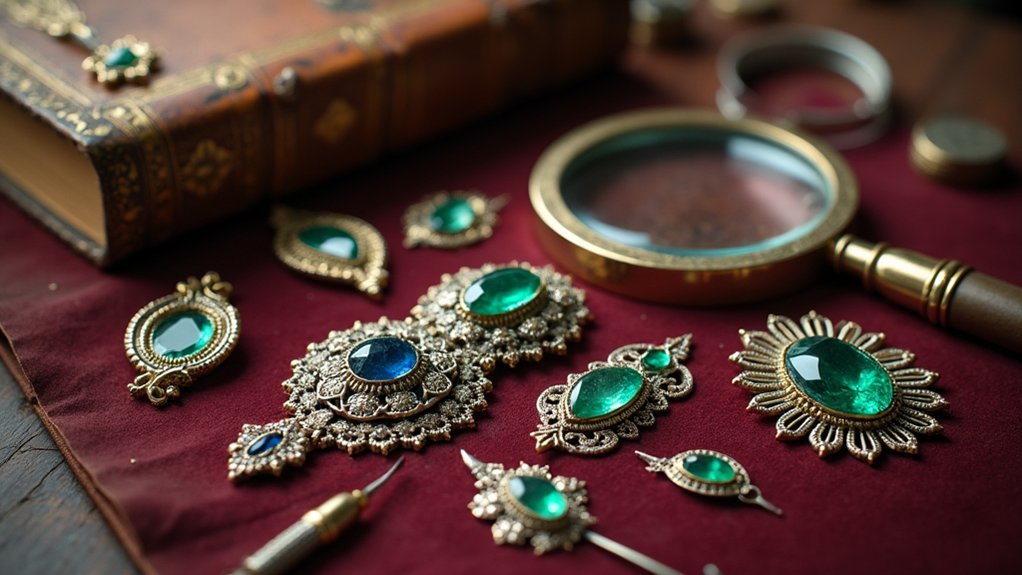
Before you can confidently restore or sell vintage jewelry, you’ll need to authenticate each piece through systematic historical research.
Start by examining identifying marks, stamps, and hallmarks that reveal the maker, era, and origin. These markings considerably enhance your piece’s value and establish provenance.
Hallmarks and maker’s stamps are the fingerprints of vintage jewelry, unlocking secrets of age, origin, and authentic value.
Understanding each era’s distinctive style and craftsmanship characteristics helps verify authenticity during the authentication process.
Document any available history, including previous ownership records or sales documentation.
- Consult reputable antique jewelry guides and specialized databases to verify authenticity and identify period-specific design features
- Engage professional appraisers or historians who specialize in vintage pieces for thorough authentication
- Research the work of expert craftsmen from relevant time periods to compare techniques and materials
This detailed research process guarantees you’re working with genuine vintage pieces worth restoring.
Creative Redesign Using Original Elements
Once you’ve authenticated your vintage pieces, you can transform them into contemporary treasures through thoughtful redesign that honors their original character.
Creative redesign breathes new life into vintage jewelry by repurposing original components while preserving sentimental value. You’ll want to work with skilled jewelers who understand original craftsmanship and can maintain aesthetic integrity during updates.
Your redesign project requires meticulous planning to incorporate contemporary elements like new settings or materials alongside vintage stones. This approach creates unique pieces that appeal to broader audiences.
Skilled jewelers can use original gemstones or motifs to craft entirely new designs that honor the piece’s history. You’re fundamentally transforming damaged or outdated jewelry into fresh, fashionable pieces that enhance both usability and marketability while keeping treasured memories intact.
Frequently Asked Questions
How to Bring Old Jewelry Back to Life?
You’ll start by gently cleaning with soft brushes and mild soap. Replace missing stones, consider professional replating for worn metals, and schedule annual inspections to maintain your jewelry’s beauty and structural integrity.
How to Turn Old Jewelry Into New?
You can transform old jewelry by resizing pieces for better fit, replating worn surfaces, replacing missing stones, redesigning damaged items into modern styles, and restoring decorative elements like enamel.
How Do You Clean Tarnished Antique Jewelry?
You’ll clean tarnished antique jewelry by making a baking soda paste with water, applying it gently with a soft cloth, rinsing thoroughly with cool water, then buffing with a lint-free cloth.
How Do You Know if Old Jewelry Is Worth Anything?
You’ll need to check for precious metals, examine any gemstones, look for maker’s marks or hallmarks, research the piece’s age and rarity, then consult a professional appraiser for accurate valuation.
In Summary
You’ve now mastered the essential techniques for breathing new life into treasured vintage pieces. Whether you’re cleaning delicate settings, replacing missing stones, or researching historical authenticity, these methods will transform neglected jewelry into stunning heirlooms. Don’t rush the process—each piece deserves careful attention to preserve its character while ensuring modern durability. Your restored vintage jewelry won’t just sparkle again; it’ll carry its story forward for generations to cherish and wear.

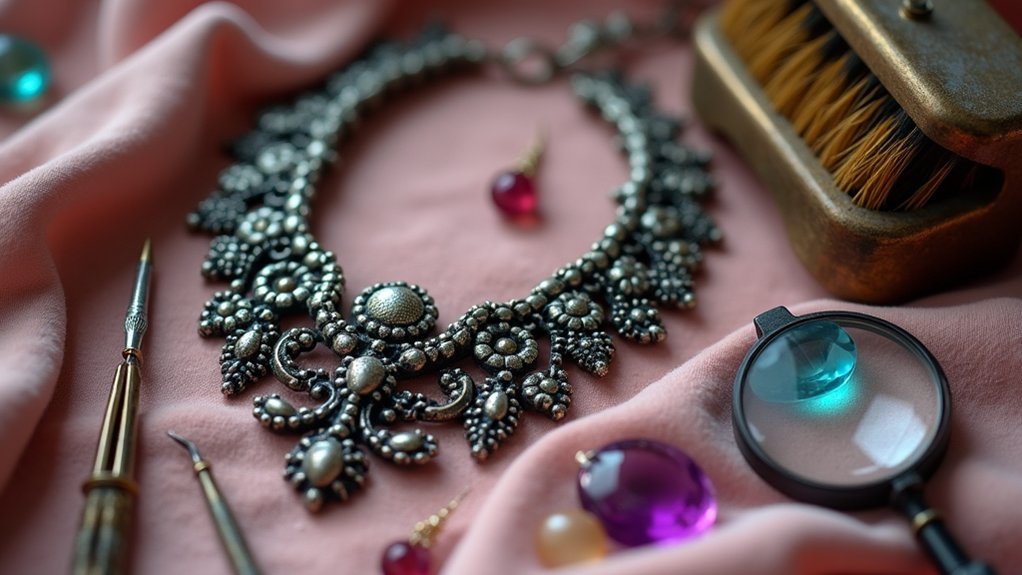



Leave a Reply